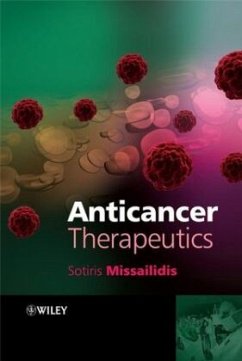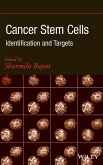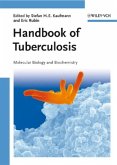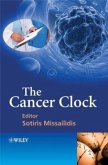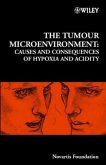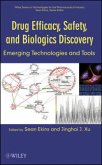Sotiris Missailidis
Anticancer Therapeutics
Sotiris Missailidis
Anticancer Therapeutics
- Gebundenes Buch
- Merkliste
- Auf die Merkliste
- Bewerten Bewerten
- Teilen
- Produkt teilen
- Produkterinnerung
- Produkterinnerung
The need to re-address known anti-cancer agents and discover new ones are of paramount importance. Anticancer Therapeutics provides a comprehensive overview of the wealth of information currently available on this important and fast-moving subject. The book provides a clear introduction to the area, with a historical overview of initial developments of cancer therapeutics and their progress in today's multidisciplinary approach to cancer treatment. Coverage includes currently used mainline molecular treatment approaches as well as "the drugs of tomorrow," making this an invaluable resource for…mehr
Andere Kunden interessierten sich auch für
![Cancer Stem Cells Cancer Stem Cells]() Cancer Stem Cells132,99 €
Cancer Stem Cells132,99 €![Molecular Biology and Biochemistry Molecular Biology and Biochemistry]() Stefan H. E. Kaufmann / Eric Rubin (eds.)Molecular Biology and Biochemistry341,06 €
Stefan H. E. Kaufmann / Eric Rubin (eds.)Molecular Biology and Biochemistry341,06 €![The Cancer Clock The Cancer Clock]() Sotiris Missailidis (ed.)The Cancer Clock87,99 €
Sotiris Missailidis (ed.)The Cancer Clock87,99 €![Emerging Cancer Therapy Emerging Cancer Therapy]() Emerging Cancer Therapy183,99 €
Emerging Cancer Therapy183,99 €![Cancer Biomarkers Cancer Biomarkers]() Mahmoud H. HamdanCancer Biomarkers190,99 €
Mahmoud H. HamdanCancer Biomarkers190,99 €![The Tumour Microenvironment The Tumour Microenvironment]() Novartis FoundationThe Tumour Microenvironment231,99 €
Novartis FoundationThe Tumour Microenvironment231,99 €![Drug Efficacy, Safety, and Biologics Discovery Drug Efficacy, Safety, and Biologics Discovery]() Drug Efficacy, Safety, and Biologics Discovery183,99 €
Drug Efficacy, Safety, and Biologics Discovery183,99 €-
-
-
The need to re-address known anti-cancer agents and discover new ones are of paramount importance. Anticancer Therapeutics provides a comprehensive overview of the wealth of information currently available on this important and fast-moving subject. The book provides a clear introduction to the area, with a historical overview of initial developments of cancer therapeutics and their progress in today's multidisciplinary approach to cancer treatment. Coverage includes currently used mainline molecular treatment approaches as well as "the drugs of tomorrow," making this an invaluable resource for postgraduates and researchers.
Krebs steht bei den Todesursachen weltweit an zweiter Stelle. Die Forschung konzentriert sich zunehmend darauf, die Entstehung von Krebs ganzheitlich zu betrachten, bekannte Krebsmedikamente auf den Prüfstand zu stellen und Medikamente und kombinierte Therapieansätze zu entwickeln.
Hinweis: Dieser Artikel kann nur an eine deutsche Lieferadresse ausgeliefert werden.
Krebs steht bei den Todesursachen weltweit an zweiter Stelle. Die Forschung konzentriert sich zunehmend darauf, die Entstehung von Krebs ganzheitlich zu betrachten, bekannte Krebsmedikamente auf den Prüfstand zu stellen und Medikamente und kombinierte Therapieansätze zu entwickeln.
Hinweis: Dieser Artikel kann nur an eine deutsche Lieferadresse ausgeliefert werden.
Produktdetails
- Produktdetails
- Verlag: Wiley & Sons
- Artikelnr. des Verlages: 14572303000
- 1. Auflage
- Seitenzahl: 424
- Erscheinungstermin: 15. Dezember 2008
- Englisch
- Abmessung: 249mm x 173mm x 28mm
- Gewicht: 868g
- ISBN-13: 9780470723036
- ISBN-10: 0470723033
- Artikelnr.: 23820836
- Herstellerkennzeichnung
- Produktsicherheitsverantwortliche/r
- Europaallee 1
- 36244 Bad Hersfeld
- gpsr@libri.de
- Verlag: Wiley & Sons
- Artikelnr. des Verlages: 14572303000
- 1. Auflage
- Seitenzahl: 424
- Erscheinungstermin: 15. Dezember 2008
- Englisch
- Abmessung: 249mm x 173mm x 28mm
- Gewicht: 868g
- ISBN-13: 9780470723036
- ISBN-10: 0470723033
- Artikelnr.: 23820836
- Herstellerkennzeichnung
- Produktsicherheitsverantwortliche/r
- Europaallee 1
- 36244 Bad Hersfeld
- gpsr@libri.de
Dr Sotiris Missailidis. Department of Chemistry and Analytical Sciences, The Open University, Milton Keynes, UK.
Forward xiii
Acknowledgements xv
List of contributors xvii
Section I: Development of Anticancer Therapeutics 1
1 Exploring the Potential of Natural Products in Cancer Treatment 3
Fotini N. Lamari and Paul Cordopatis
1.1 Introduction 3
1.2 Sources 4
1.3 Different Approaches to the Search for Bioactive Natural Products 6
1.4 Methodologies of Lead Compound or New Drug Identification 10
1.5 Chemoprevention - A New Area for Natural Product Research 13
1.6 Concluding Remarks 13
2 Combinatorial Approaches to Anticancer Drug Design 17
Sotiris Missailidis
2.1 Introduction 17
2.2 Combinatorial Approaches for Small Molecule Drug Design 17
2.3 Display Technologies 21
2.4 Aptamer Selection 23
2.5 Conclusions 27
3 Rational Approaches to Anticancer Drug Design/in silico Drug Development
29
Stefano Alcaro, Anna Artese and Francesco Ortuso
3.1 Introduction 29
3.2 Approaches to the Drug Discovery Process in Anticancer Research 31
3.3 Ligand-based Examples 32
3.4 Structure-based Examples 36
3.5 Conclusions 44
Section II: Anticancer Therapeutics 47
4 Introduction to Anticancer Therapeutics 49
Teni Boulikas
4.1 Problems in cancer 49
4.2 Cancer treatments 51
4.3 Classification of chemotherapy drugs 53
5 Platinum Drugs 55
Teni Boulikas, Alexandros Pantos, Evagelos Bellis and Petros Christofis
5.1 Cisplatin 55
5.2 Lipoplatin 57
5.3 Carboplatin 61
5.4 Oxaliplatin 62
5.5 Lipoxal 62
5.6 New Platinum Compounds 64
5.7 Cisplatin Resistance and Chemotherapy 70
6 Antimicrotubule Agents 79
Iain Brown, Jay N Sangrithi-Wallace and Andrew C Schofield
6.1 Taxanes 79
6.2 Vinca Alkaloids 82
6.3 Mechanisms of Resistance to Antimicrotubule Agents 86
7 Antimetabolites in Cancer Therapy 91
Jessica Scaife and David Kerr
7.1 Introduction 91
7.2 Folate Antagonists 92
7.3 Pyrimidine Antagonists 96
7.4 Purine Antagonists 104
7.5 Summary 109
8 Antitumour Antibiotics 111
Manuel M. Paz
8.1 Introduction 111
8.2 Actinomycin 111
8.3 Mitomycin c 112
8.4 Bleomycin 115
8.5 Anthracyclines 118
8.6 Trabectedin (Ecteinascidin, ET-743) 121
8.7 Camptothecins 123
8.8 Podophyllotoxins 124
9 Alkylating Agents 133
Ana Paula Francisco, Maria de Jesus Perry, Rui Moreira and Eduarda Mendes
9.1 Introduction 133
9.2 Nitrogen Mustards 133
9.3 Methylmelamines and Ethylenimines 140
9.4 Methylhydrazine Derivatives 141
9.5 Alkylsulfonates 143
9.6 Nitrosoureas 144
9.7 Triazenes 149
10 Hormone Therapies 159
George C. Zografos, Nikolaos V. Michalopoulos and Flora Zagouri
10.1 Introduction 159
10.2 Oestrogen Receptor Targeted Therapeutics 160
10.3 Progesterone-Targeted Therapy 174
10.4 Neuroendocrine Tumours 176
11 Photodynamic Therapy of Cancer 187
K. Eszter Borbas and Dorothée Lahaye
11.1 Introduction 187
11.2 Photosensitizers 196
11.3 Outlook 212
11.4 Acknowledgement 212
12 Target-directed Drug Discovery 223
Tracey D. Bradshaw
12.1 Introduction 223
12.2 Tyrosine Kinases - Role and Significance in Cancer 226
12.3 Targeted Therapy for the Treatment of Non-small Cell Lung Cancer
(NSCLC) 226
12.4 Targeted Therapy for the Treatment of Chronic Myeloid Leukaemia 229
12.5 Targeted Therapy for the Treatment of Breast Cancer 230
12.6 Angiogenesis 231
12.7 Targeting Cell Cycling 235
12.8 Targeting Apoptosis 237
12.9 Targeting mTOR 237
12.10 The Future of Molecularly Targeted Therapy 238
13 Tumour Hypoxia: Malignant Mediator 245
Jill L. O'Donnell, Aoife M. Shannon, David Bouchier-Hayes
13.1 Introduction 245
13.2 Hypoxia Inducible Factor-1 and Hypoxia 246
13.3 HIF-1¿ Post-translational Changes 247
13.4 How Genetics Can Modify HIF 248
13.5 How Tumours Overcome Hypoxia with HIF- 1 249
13.6 HIF-1 Therapeutics 252
13.7 Conclusion 255
14 Resistance to Chemotherapy Drugs 263
Robert O'Connor and Laura Breen
14.1 Introduction 263
14.2 What are the Factors Limiting the Efficacy of Cancer Chemotherapy
Treatment? 263
14.3 A Classification of the Important Chemotherapy Resistance Mechanisms
265
14.4 Illustrative Mechanisms of Pharmacokinetic Resistance 267
14.5 Illustrative Mechanisms of Pharmacodynamic Resistance 273
14.6 Conclusion 277
15 Cancer Immunotherapy 283
Maria Belimezi
15.1 The Molecular Basis of Cancer Immunotherapy and Gene Immunotherapy of
Cancer 283
15.2 Recombinant Monoclonal Antibodies 284
15.3 Cell Immunotherapy 292
15.4 Cancer Vaccines 296
16 Gene Therapy 305
Maria Belimezi, Teni Boulikas and Michael L. Roberts
16.1 The Concept of Gene Therapy 305
16.2 Steps for Successful Gene Therapy 306
16.3 Retroviruses in Cancer Gene Therapy 307
16.4 Adenoviruses in Cancer Gene Therapy 308
16.5 Gene Therapy of Cancer 310
16.6 Cancer Immunotherapy with Cytokine Genes 311
16.7 IL-12 in Cancer Immunotherapy 311
16.8 Viruses able to Kill Cancer Cells 314
17 Antisense Agents 317
Huma Khan and Sotiris Missailidis
17.1 Introduction 317
17.2 Traditional Antisense Oligonucleotides (ASOs) 318
17.3 Ribozymes and DNAzymes 320
17.4 RNA Interference and siRNAs 321
17.5 Shortcomings of Antisense Therapeutics 322
17.6 Antisense Agents in Clinical Trials 324
17.7 Concluding Remarks 329
18 Aptamers as Anticancer Agents 331
Vaidehi Makwana, Suzanne Simmons and Sotiris Missailidis
18.1 Introduction 331
18.2 Aptamers in Cancer 332
18.3 Final comments 341
Section III: Other Aspects in Anticancer Therapeutic Development 347
19 Treatment of Cancer in Conjunction with Other Agents 349
Gary Robert Smith
19.1 Introduction 349
19.2 Non-steroidal Anti-inflammatory Drugs 353
19.3 Angiotensin-converting Enzyme (ACE) Inhibitors and Angiotensin
Receptor Blockade 358
19.4 Partners in Crime - Dealing with Co-infections 362
19.5 Discussion 363
20 Clinical Trials in Oncology 365
Tim Friede, Janet Dunn and Nigel Stallard
20.1 Clinical Trials 365
20.2 Early-Phase (Phase I and Phase II) Clinical Trials in Oncology 368
20.3 Confirmatory (Phase III) Trials in Oncology 371
20.4 Further Issues in Clinical Trials in Oncology 374
21 Representative Cancers, Treatment and Market 377
Teni Boulikas and Nassos Alevizopoulos
21.1 Lung Cancer 377
21.2 Breast Cancer 378
21.3 Prostate Cancer 378
21.4 Colorectal Cancer 379
21.5 Ovarian Cancer 380
21.6 Pancreatic Cancer 380
21.7 Gastric Cancer 381
21.8 Combination Chemotherapy 382
21.9 The Pharmaceutical World of Anticancer Drugs 383
22 Future Trends in Cancer Therapeutics 387
Sotiris Missailidis
22.1 Introduction 387
22.2 Personalized Medicines 388
22.3 Delivery Systems 390
22.4 Closing Remarks 391
Index 393
Acknowledgements xv
List of contributors xvii
Section I: Development of Anticancer Therapeutics 1
1 Exploring the Potential of Natural Products in Cancer Treatment 3
Fotini N. Lamari and Paul Cordopatis
1.1 Introduction 3
1.2 Sources 4
1.3 Different Approaches to the Search for Bioactive Natural Products 6
1.4 Methodologies of Lead Compound or New Drug Identification 10
1.5 Chemoprevention - A New Area for Natural Product Research 13
1.6 Concluding Remarks 13
2 Combinatorial Approaches to Anticancer Drug Design 17
Sotiris Missailidis
2.1 Introduction 17
2.2 Combinatorial Approaches for Small Molecule Drug Design 17
2.3 Display Technologies 21
2.4 Aptamer Selection 23
2.5 Conclusions 27
3 Rational Approaches to Anticancer Drug Design/in silico Drug Development
29
Stefano Alcaro, Anna Artese and Francesco Ortuso
3.1 Introduction 29
3.2 Approaches to the Drug Discovery Process in Anticancer Research 31
3.3 Ligand-based Examples 32
3.4 Structure-based Examples 36
3.5 Conclusions 44
Section II: Anticancer Therapeutics 47
4 Introduction to Anticancer Therapeutics 49
Teni Boulikas
4.1 Problems in cancer 49
4.2 Cancer treatments 51
4.3 Classification of chemotherapy drugs 53
5 Platinum Drugs 55
Teni Boulikas, Alexandros Pantos, Evagelos Bellis and Petros Christofis
5.1 Cisplatin 55
5.2 Lipoplatin 57
5.3 Carboplatin 61
5.4 Oxaliplatin 62
5.5 Lipoxal 62
5.6 New Platinum Compounds 64
5.7 Cisplatin Resistance and Chemotherapy 70
6 Antimicrotubule Agents 79
Iain Brown, Jay N Sangrithi-Wallace and Andrew C Schofield
6.1 Taxanes 79
6.2 Vinca Alkaloids 82
6.3 Mechanisms of Resistance to Antimicrotubule Agents 86
7 Antimetabolites in Cancer Therapy 91
Jessica Scaife and David Kerr
7.1 Introduction 91
7.2 Folate Antagonists 92
7.3 Pyrimidine Antagonists 96
7.4 Purine Antagonists 104
7.5 Summary 109
8 Antitumour Antibiotics 111
Manuel M. Paz
8.1 Introduction 111
8.2 Actinomycin 111
8.3 Mitomycin c 112
8.4 Bleomycin 115
8.5 Anthracyclines 118
8.6 Trabectedin (Ecteinascidin, ET-743) 121
8.7 Camptothecins 123
8.8 Podophyllotoxins 124
9 Alkylating Agents 133
Ana Paula Francisco, Maria de Jesus Perry, Rui Moreira and Eduarda Mendes
9.1 Introduction 133
9.2 Nitrogen Mustards 133
9.3 Methylmelamines and Ethylenimines 140
9.4 Methylhydrazine Derivatives 141
9.5 Alkylsulfonates 143
9.6 Nitrosoureas 144
9.7 Triazenes 149
10 Hormone Therapies 159
George C. Zografos, Nikolaos V. Michalopoulos and Flora Zagouri
10.1 Introduction 159
10.2 Oestrogen Receptor Targeted Therapeutics 160
10.3 Progesterone-Targeted Therapy 174
10.4 Neuroendocrine Tumours 176
11 Photodynamic Therapy of Cancer 187
K. Eszter Borbas and Dorothée Lahaye
11.1 Introduction 187
11.2 Photosensitizers 196
11.3 Outlook 212
11.4 Acknowledgement 212
12 Target-directed Drug Discovery 223
Tracey D. Bradshaw
12.1 Introduction 223
12.2 Tyrosine Kinases - Role and Significance in Cancer 226
12.3 Targeted Therapy for the Treatment of Non-small Cell Lung Cancer
(NSCLC) 226
12.4 Targeted Therapy for the Treatment of Chronic Myeloid Leukaemia 229
12.5 Targeted Therapy for the Treatment of Breast Cancer 230
12.6 Angiogenesis 231
12.7 Targeting Cell Cycling 235
12.8 Targeting Apoptosis 237
12.9 Targeting mTOR 237
12.10 The Future of Molecularly Targeted Therapy 238
13 Tumour Hypoxia: Malignant Mediator 245
Jill L. O'Donnell, Aoife M. Shannon, David Bouchier-Hayes
13.1 Introduction 245
13.2 Hypoxia Inducible Factor-1 and Hypoxia 246
13.3 HIF-1¿ Post-translational Changes 247
13.4 How Genetics Can Modify HIF 248
13.5 How Tumours Overcome Hypoxia with HIF- 1 249
13.6 HIF-1 Therapeutics 252
13.7 Conclusion 255
14 Resistance to Chemotherapy Drugs 263
Robert O'Connor and Laura Breen
14.1 Introduction 263
14.2 What are the Factors Limiting the Efficacy of Cancer Chemotherapy
Treatment? 263
14.3 A Classification of the Important Chemotherapy Resistance Mechanisms
265
14.4 Illustrative Mechanisms of Pharmacokinetic Resistance 267
14.5 Illustrative Mechanisms of Pharmacodynamic Resistance 273
14.6 Conclusion 277
15 Cancer Immunotherapy 283
Maria Belimezi
15.1 The Molecular Basis of Cancer Immunotherapy and Gene Immunotherapy of
Cancer 283
15.2 Recombinant Monoclonal Antibodies 284
15.3 Cell Immunotherapy 292
15.4 Cancer Vaccines 296
16 Gene Therapy 305
Maria Belimezi, Teni Boulikas and Michael L. Roberts
16.1 The Concept of Gene Therapy 305
16.2 Steps for Successful Gene Therapy 306
16.3 Retroviruses in Cancer Gene Therapy 307
16.4 Adenoviruses in Cancer Gene Therapy 308
16.5 Gene Therapy of Cancer 310
16.6 Cancer Immunotherapy with Cytokine Genes 311
16.7 IL-12 in Cancer Immunotherapy 311
16.8 Viruses able to Kill Cancer Cells 314
17 Antisense Agents 317
Huma Khan and Sotiris Missailidis
17.1 Introduction 317
17.2 Traditional Antisense Oligonucleotides (ASOs) 318
17.3 Ribozymes and DNAzymes 320
17.4 RNA Interference and siRNAs 321
17.5 Shortcomings of Antisense Therapeutics 322
17.6 Antisense Agents in Clinical Trials 324
17.7 Concluding Remarks 329
18 Aptamers as Anticancer Agents 331
Vaidehi Makwana, Suzanne Simmons and Sotiris Missailidis
18.1 Introduction 331
18.2 Aptamers in Cancer 332
18.3 Final comments 341
Section III: Other Aspects in Anticancer Therapeutic Development 347
19 Treatment of Cancer in Conjunction with Other Agents 349
Gary Robert Smith
19.1 Introduction 349
19.2 Non-steroidal Anti-inflammatory Drugs 353
19.3 Angiotensin-converting Enzyme (ACE) Inhibitors and Angiotensin
Receptor Blockade 358
19.4 Partners in Crime - Dealing with Co-infections 362
19.5 Discussion 363
20 Clinical Trials in Oncology 365
Tim Friede, Janet Dunn and Nigel Stallard
20.1 Clinical Trials 365
20.2 Early-Phase (Phase I and Phase II) Clinical Trials in Oncology 368
20.3 Confirmatory (Phase III) Trials in Oncology 371
20.4 Further Issues in Clinical Trials in Oncology 374
21 Representative Cancers, Treatment and Market 377
Teni Boulikas and Nassos Alevizopoulos
21.1 Lung Cancer 377
21.2 Breast Cancer 378
21.3 Prostate Cancer 378
21.4 Colorectal Cancer 379
21.5 Ovarian Cancer 380
21.6 Pancreatic Cancer 380
21.7 Gastric Cancer 381
21.8 Combination Chemotherapy 382
21.9 The Pharmaceutical World of Anticancer Drugs 383
22 Future Trends in Cancer Therapeutics 387
Sotiris Missailidis
22.1 Introduction 387
22.2 Personalized Medicines 388
22.3 Delivery Systems 390
22.4 Closing Remarks 391
Index 393
Forward xiii
Acknowledgements xv
List of contributors xvii
Section I: Development of Anticancer Therapeutics 1
1 Exploring the Potential of Natural Products in Cancer Treatment 3
Fotini N. Lamari and Paul Cordopatis
1.1 Introduction 3
1.2 Sources 4
1.3 Different Approaches to the Search for Bioactive Natural Products 6
1.4 Methodologies of Lead Compound or New Drug Identification 10
1.5 Chemoprevention - A New Area for Natural Product Research 13
1.6 Concluding Remarks 13
2 Combinatorial Approaches to Anticancer Drug Design 17
Sotiris Missailidis
2.1 Introduction 17
2.2 Combinatorial Approaches for Small Molecule Drug Design 17
2.3 Display Technologies 21
2.4 Aptamer Selection 23
2.5 Conclusions 27
3 Rational Approaches to Anticancer Drug Design/in silico Drug Development
29
Stefano Alcaro, Anna Artese and Francesco Ortuso
3.1 Introduction 29
3.2 Approaches to the Drug Discovery Process in Anticancer Research 31
3.3 Ligand-based Examples 32
3.4 Structure-based Examples 36
3.5 Conclusions 44
Section II: Anticancer Therapeutics 47
4 Introduction to Anticancer Therapeutics 49
Teni Boulikas
4.1 Problems in cancer 49
4.2 Cancer treatments 51
4.3 Classification of chemotherapy drugs 53
5 Platinum Drugs 55
Teni Boulikas, Alexandros Pantos, Evagelos Bellis and Petros Christofis
5.1 Cisplatin 55
5.2 Lipoplatin 57
5.3 Carboplatin 61
5.4 Oxaliplatin 62
5.5 Lipoxal 62
5.6 New Platinum Compounds 64
5.7 Cisplatin Resistance and Chemotherapy 70
6 Antimicrotubule Agents 79
Iain Brown, Jay N Sangrithi-Wallace and Andrew C Schofield
6.1 Taxanes 79
6.2 Vinca Alkaloids 82
6.3 Mechanisms of Resistance to Antimicrotubule Agents 86
7 Antimetabolites in Cancer Therapy 91
Jessica Scaife and David Kerr
7.1 Introduction 91
7.2 Folate Antagonists 92
7.3 Pyrimidine Antagonists 96
7.4 Purine Antagonists 104
7.5 Summary 109
8 Antitumour Antibiotics 111
Manuel M. Paz
8.1 Introduction 111
8.2 Actinomycin 111
8.3 Mitomycin c 112
8.4 Bleomycin 115
8.5 Anthracyclines 118
8.6 Trabectedin (Ecteinascidin, ET-743) 121
8.7 Camptothecins 123
8.8 Podophyllotoxins 124
9 Alkylating Agents 133
Ana Paula Francisco, Maria de Jesus Perry, Rui Moreira and Eduarda Mendes
9.1 Introduction 133
9.2 Nitrogen Mustards 133
9.3 Methylmelamines and Ethylenimines 140
9.4 Methylhydrazine Derivatives 141
9.5 Alkylsulfonates 143
9.6 Nitrosoureas 144
9.7 Triazenes 149
10 Hormone Therapies 159
George C. Zografos, Nikolaos V. Michalopoulos and Flora Zagouri
10.1 Introduction 159
10.2 Oestrogen Receptor Targeted Therapeutics 160
10.3 Progesterone-Targeted Therapy 174
10.4 Neuroendocrine Tumours 176
11 Photodynamic Therapy of Cancer 187
K. Eszter Borbas and Dorothée Lahaye
11.1 Introduction 187
11.2 Photosensitizers 196
11.3 Outlook 212
11.4 Acknowledgement 212
12 Target-directed Drug Discovery 223
Tracey D. Bradshaw
12.1 Introduction 223
12.2 Tyrosine Kinases - Role and Significance in Cancer 226
12.3 Targeted Therapy for the Treatment of Non-small Cell Lung Cancer
(NSCLC) 226
12.4 Targeted Therapy for the Treatment of Chronic Myeloid Leukaemia 229
12.5 Targeted Therapy for the Treatment of Breast Cancer 230
12.6 Angiogenesis 231
12.7 Targeting Cell Cycling 235
12.8 Targeting Apoptosis 237
12.9 Targeting mTOR 237
12.10 The Future of Molecularly Targeted Therapy 238
13 Tumour Hypoxia: Malignant Mediator 245
Jill L. O'Donnell, Aoife M. Shannon, David Bouchier-Hayes
13.1 Introduction 245
13.2 Hypoxia Inducible Factor-1 and Hypoxia 246
13.3 HIF-1¿ Post-translational Changes 247
13.4 How Genetics Can Modify HIF 248
13.5 How Tumours Overcome Hypoxia with HIF- 1 249
13.6 HIF-1 Therapeutics 252
13.7 Conclusion 255
14 Resistance to Chemotherapy Drugs 263
Robert O'Connor and Laura Breen
14.1 Introduction 263
14.2 What are the Factors Limiting the Efficacy of Cancer Chemotherapy
Treatment? 263
14.3 A Classification of the Important Chemotherapy Resistance Mechanisms
265
14.4 Illustrative Mechanisms of Pharmacokinetic Resistance 267
14.5 Illustrative Mechanisms of Pharmacodynamic Resistance 273
14.6 Conclusion 277
15 Cancer Immunotherapy 283
Maria Belimezi
15.1 The Molecular Basis of Cancer Immunotherapy and Gene Immunotherapy of
Cancer 283
15.2 Recombinant Monoclonal Antibodies 284
15.3 Cell Immunotherapy 292
15.4 Cancer Vaccines 296
16 Gene Therapy 305
Maria Belimezi, Teni Boulikas and Michael L. Roberts
16.1 The Concept of Gene Therapy 305
16.2 Steps for Successful Gene Therapy 306
16.3 Retroviruses in Cancer Gene Therapy 307
16.4 Adenoviruses in Cancer Gene Therapy 308
16.5 Gene Therapy of Cancer 310
16.6 Cancer Immunotherapy with Cytokine Genes 311
16.7 IL-12 in Cancer Immunotherapy 311
16.8 Viruses able to Kill Cancer Cells 314
17 Antisense Agents 317
Huma Khan and Sotiris Missailidis
17.1 Introduction 317
17.2 Traditional Antisense Oligonucleotides (ASOs) 318
17.3 Ribozymes and DNAzymes 320
17.4 RNA Interference and siRNAs 321
17.5 Shortcomings of Antisense Therapeutics 322
17.6 Antisense Agents in Clinical Trials 324
17.7 Concluding Remarks 329
18 Aptamers as Anticancer Agents 331
Vaidehi Makwana, Suzanne Simmons and Sotiris Missailidis
18.1 Introduction 331
18.2 Aptamers in Cancer 332
18.3 Final comments 341
Section III: Other Aspects in Anticancer Therapeutic Development 347
19 Treatment of Cancer in Conjunction with Other Agents 349
Gary Robert Smith
19.1 Introduction 349
19.2 Non-steroidal Anti-inflammatory Drugs 353
19.3 Angiotensin-converting Enzyme (ACE) Inhibitors and Angiotensin
Receptor Blockade 358
19.4 Partners in Crime - Dealing with Co-infections 362
19.5 Discussion 363
20 Clinical Trials in Oncology 365
Tim Friede, Janet Dunn and Nigel Stallard
20.1 Clinical Trials 365
20.2 Early-Phase (Phase I and Phase II) Clinical Trials in Oncology 368
20.3 Confirmatory (Phase III) Trials in Oncology 371
20.4 Further Issues in Clinical Trials in Oncology 374
21 Representative Cancers, Treatment and Market 377
Teni Boulikas and Nassos Alevizopoulos
21.1 Lung Cancer 377
21.2 Breast Cancer 378
21.3 Prostate Cancer 378
21.4 Colorectal Cancer 379
21.5 Ovarian Cancer 380
21.6 Pancreatic Cancer 380
21.7 Gastric Cancer 381
21.8 Combination Chemotherapy 382
21.9 The Pharmaceutical World of Anticancer Drugs 383
22 Future Trends in Cancer Therapeutics 387
Sotiris Missailidis
22.1 Introduction 387
22.2 Personalized Medicines 388
22.3 Delivery Systems 390
22.4 Closing Remarks 391
Index 393
Acknowledgements xv
List of contributors xvii
Section I: Development of Anticancer Therapeutics 1
1 Exploring the Potential of Natural Products in Cancer Treatment 3
Fotini N. Lamari and Paul Cordopatis
1.1 Introduction 3
1.2 Sources 4
1.3 Different Approaches to the Search for Bioactive Natural Products 6
1.4 Methodologies of Lead Compound or New Drug Identification 10
1.5 Chemoprevention - A New Area for Natural Product Research 13
1.6 Concluding Remarks 13
2 Combinatorial Approaches to Anticancer Drug Design 17
Sotiris Missailidis
2.1 Introduction 17
2.2 Combinatorial Approaches for Small Molecule Drug Design 17
2.3 Display Technologies 21
2.4 Aptamer Selection 23
2.5 Conclusions 27
3 Rational Approaches to Anticancer Drug Design/in silico Drug Development
29
Stefano Alcaro, Anna Artese and Francesco Ortuso
3.1 Introduction 29
3.2 Approaches to the Drug Discovery Process in Anticancer Research 31
3.3 Ligand-based Examples 32
3.4 Structure-based Examples 36
3.5 Conclusions 44
Section II: Anticancer Therapeutics 47
4 Introduction to Anticancer Therapeutics 49
Teni Boulikas
4.1 Problems in cancer 49
4.2 Cancer treatments 51
4.3 Classification of chemotherapy drugs 53
5 Platinum Drugs 55
Teni Boulikas, Alexandros Pantos, Evagelos Bellis and Petros Christofis
5.1 Cisplatin 55
5.2 Lipoplatin 57
5.3 Carboplatin 61
5.4 Oxaliplatin 62
5.5 Lipoxal 62
5.6 New Platinum Compounds 64
5.7 Cisplatin Resistance and Chemotherapy 70
6 Antimicrotubule Agents 79
Iain Brown, Jay N Sangrithi-Wallace and Andrew C Schofield
6.1 Taxanes 79
6.2 Vinca Alkaloids 82
6.3 Mechanisms of Resistance to Antimicrotubule Agents 86
7 Antimetabolites in Cancer Therapy 91
Jessica Scaife and David Kerr
7.1 Introduction 91
7.2 Folate Antagonists 92
7.3 Pyrimidine Antagonists 96
7.4 Purine Antagonists 104
7.5 Summary 109
8 Antitumour Antibiotics 111
Manuel M. Paz
8.1 Introduction 111
8.2 Actinomycin 111
8.3 Mitomycin c 112
8.4 Bleomycin 115
8.5 Anthracyclines 118
8.6 Trabectedin (Ecteinascidin, ET-743) 121
8.7 Camptothecins 123
8.8 Podophyllotoxins 124
9 Alkylating Agents 133
Ana Paula Francisco, Maria de Jesus Perry, Rui Moreira and Eduarda Mendes
9.1 Introduction 133
9.2 Nitrogen Mustards 133
9.3 Methylmelamines and Ethylenimines 140
9.4 Methylhydrazine Derivatives 141
9.5 Alkylsulfonates 143
9.6 Nitrosoureas 144
9.7 Triazenes 149
10 Hormone Therapies 159
George C. Zografos, Nikolaos V. Michalopoulos and Flora Zagouri
10.1 Introduction 159
10.2 Oestrogen Receptor Targeted Therapeutics 160
10.3 Progesterone-Targeted Therapy 174
10.4 Neuroendocrine Tumours 176
11 Photodynamic Therapy of Cancer 187
K. Eszter Borbas and Dorothée Lahaye
11.1 Introduction 187
11.2 Photosensitizers 196
11.3 Outlook 212
11.4 Acknowledgement 212
12 Target-directed Drug Discovery 223
Tracey D. Bradshaw
12.1 Introduction 223
12.2 Tyrosine Kinases - Role and Significance in Cancer 226
12.3 Targeted Therapy for the Treatment of Non-small Cell Lung Cancer
(NSCLC) 226
12.4 Targeted Therapy for the Treatment of Chronic Myeloid Leukaemia 229
12.5 Targeted Therapy for the Treatment of Breast Cancer 230
12.6 Angiogenesis 231
12.7 Targeting Cell Cycling 235
12.8 Targeting Apoptosis 237
12.9 Targeting mTOR 237
12.10 The Future of Molecularly Targeted Therapy 238
13 Tumour Hypoxia: Malignant Mediator 245
Jill L. O'Donnell, Aoife M. Shannon, David Bouchier-Hayes
13.1 Introduction 245
13.2 Hypoxia Inducible Factor-1 and Hypoxia 246
13.3 HIF-1¿ Post-translational Changes 247
13.4 How Genetics Can Modify HIF 248
13.5 How Tumours Overcome Hypoxia with HIF- 1 249
13.6 HIF-1 Therapeutics 252
13.7 Conclusion 255
14 Resistance to Chemotherapy Drugs 263
Robert O'Connor and Laura Breen
14.1 Introduction 263
14.2 What are the Factors Limiting the Efficacy of Cancer Chemotherapy
Treatment? 263
14.3 A Classification of the Important Chemotherapy Resistance Mechanisms
265
14.4 Illustrative Mechanisms of Pharmacokinetic Resistance 267
14.5 Illustrative Mechanisms of Pharmacodynamic Resistance 273
14.6 Conclusion 277
15 Cancer Immunotherapy 283
Maria Belimezi
15.1 The Molecular Basis of Cancer Immunotherapy and Gene Immunotherapy of
Cancer 283
15.2 Recombinant Monoclonal Antibodies 284
15.3 Cell Immunotherapy 292
15.4 Cancer Vaccines 296
16 Gene Therapy 305
Maria Belimezi, Teni Boulikas and Michael L. Roberts
16.1 The Concept of Gene Therapy 305
16.2 Steps for Successful Gene Therapy 306
16.3 Retroviruses in Cancer Gene Therapy 307
16.4 Adenoviruses in Cancer Gene Therapy 308
16.5 Gene Therapy of Cancer 310
16.6 Cancer Immunotherapy with Cytokine Genes 311
16.7 IL-12 in Cancer Immunotherapy 311
16.8 Viruses able to Kill Cancer Cells 314
17 Antisense Agents 317
Huma Khan and Sotiris Missailidis
17.1 Introduction 317
17.2 Traditional Antisense Oligonucleotides (ASOs) 318
17.3 Ribozymes and DNAzymes 320
17.4 RNA Interference and siRNAs 321
17.5 Shortcomings of Antisense Therapeutics 322
17.6 Antisense Agents in Clinical Trials 324
17.7 Concluding Remarks 329
18 Aptamers as Anticancer Agents 331
Vaidehi Makwana, Suzanne Simmons and Sotiris Missailidis
18.1 Introduction 331
18.2 Aptamers in Cancer 332
18.3 Final comments 341
Section III: Other Aspects in Anticancer Therapeutic Development 347
19 Treatment of Cancer in Conjunction with Other Agents 349
Gary Robert Smith
19.1 Introduction 349
19.2 Non-steroidal Anti-inflammatory Drugs 353
19.3 Angiotensin-converting Enzyme (ACE) Inhibitors and Angiotensin
Receptor Blockade 358
19.4 Partners in Crime - Dealing with Co-infections 362
19.5 Discussion 363
20 Clinical Trials in Oncology 365
Tim Friede, Janet Dunn and Nigel Stallard
20.1 Clinical Trials 365
20.2 Early-Phase (Phase I and Phase II) Clinical Trials in Oncology 368
20.3 Confirmatory (Phase III) Trials in Oncology 371
20.4 Further Issues in Clinical Trials in Oncology 374
21 Representative Cancers, Treatment and Market 377
Teni Boulikas and Nassos Alevizopoulos
21.1 Lung Cancer 377
21.2 Breast Cancer 378
21.3 Prostate Cancer 378
21.4 Colorectal Cancer 379
21.5 Ovarian Cancer 380
21.6 Pancreatic Cancer 380
21.7 Gastric Cancer 381
21.8 Combination Chemotherapy 382
21.9 The Pharmaceutical World of Anticancer Drugs 383
22 Future Trends in Cancer Therapeutics 387
Sotiris Missailidis
22.1 Introduction 387
22.2 Personalized Medicines 388
22.3 Delivery Systems 390
22.4 Closing Remarks 391
Index 393

